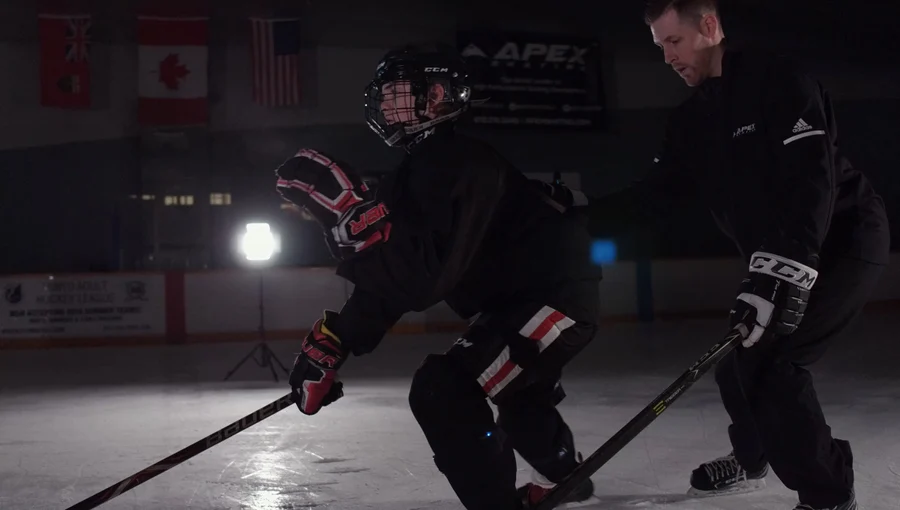Coaching Cues: External vs. Internal Focus of Attention
By Dr. Kenneth Smale, CSCS
Let’s face it, scientific research is confusing and the experts rarely agree on concepts – even the idea of ‘smoking is bad for you’ was hotly debated for many years. So when a research finding comes out that an estimate of over 90% of papers agree with, it needs to be shouted from a mountaintop.
What is this finding you say? Well, it’s the finding that compared to internal focus on how the body is moving, externally focusing one’s attention to the world around them leads to generally more effective outcomes and motor skill acquisition (Marchant, 2011; Wulf & Lewthwaite, 2016). Ok, let’s break this down and relate it to hockey and coaching.
Say a coach is trying to lengthen a player’s stride. An internal cue would be along the lines of “extend your hip and knee more” – it is directing the athlete’s attention internally to the movement of their body. An external cue on the other hand would be having the coach place their stick behind the skater at the desired stride distance and giving the cue “stride until your skate hits my stick” – you’re directing the athlete’s attention to something in the external environment around them. Another example is trying to coach a skater to get lower. Instead of saying “flex your hips and knees more”, the external approach would be holding a stick at the desired height and say “during your stride, don’t let your head touch my stick”.

So what exactly makes external cueing more effective? It’s believed to better enable athletes to reach the stage of automaticity, which is the ability of an athlete to produce a movement without having to put conscious thought into doing so. This level of automaticity is a stalwart characteristic of elite athletes in that they can perform a skill even with their eyes closed (yes, that was a Michael Jordan reference).
Let’s borrow a golf example to hammer this automaticity concept home. Say you’re faced with a 5 foot putt to win the match and you keep thinking “don’t yank this putt. Keep your arms straight and smooth stroke”. Well, by consciously thinking of the movement and interrupting the natural, automatic movement pattern you’ve honed with thousands of previous putts, you’re more likely to choke than if you simply let your body do what it has trained to do when focusing on sending the ball home.
Before we wrap up, there’s one additional piece of research to be brought up. Now that we’ve established external cueing is generally more effective, which external cues should an athlete focus on given that there are likely many possibilities in their environment? It turns out that there appears to be a distance effect to external cueing and that the more distal (far away) the focus is, the more effective it becomes (Check out Nick Winkelman’s book The Language of Coaching or his YouTube videos and I promise you won’t be disappointed). This has been researched once again in golf where the players demonstrated greater shot accuracy when focusing on the landing position (distal) compared to the club head (proximal; Bell & Hardy, 2009).
This can likely be translated to shooting in hockey: when taking a shot, a player’s focus should not be on how they fire their wrists (internal) or how the blade lines up with the puck (proximal external), but rather on the target they wish to hit with the puck (distal external). But with shooting, always remember that the opening you see with your eyes may be deceptive because it’s at a different angle than what the puck’s trajectory will be off of the stick.
The one caveat here is that if you’re working with beginners, they may benefit more from a proximal external focus because they haven’t developed the ability to ‘connect the dots’ of how the body moves to how that influences the stick/club to how that influences the trajectory of the puck/ball (Wulf et al., 2000). When working with experts though, distal external is the way to go (Bell & Hardy, 2009).
Now that you’re armed with this new knowledge about cueing, what are some examples of external cueing that you’ve always naturally done? What are some examples from your coaching sessions that likely weren’t best setting your players up for success? How can you get better? Because in the end, that’s really all that matters.
References
Bell, J. J., & Hardy, J. (2009). Effects of Attentional Focus on Skilled Performance in Golf. Journal of Applied Sport Psychology, 21(2), 163–177. https://doi.org/10.1080/10413200902795323
Marchant, D. C. (2011). Attentional Focusing Instructions and Force Production. Frontiers in Psychology, 1. https://doi.org/10.3389/fpsyg.2010.00210
Wulf, G., & Lewthwaite, R. (2016). Optimizing performance through intrinsic motivation and attention for learning: The OPTIMAL theory of motor learning. Psychonomic Bulletin & Review, 23(5), 1382–1414. https://doi.org/10.3758/s13423-015-0999-9
Wulf, G., McNevin, N. H., Fuchs, T., Ritter, F., & Toole, T. (2000). Attentional Focus in Complex Skill Learning. Research Quarterly for Exercise and Sport, 71(3), 229–239. https://doi.org/10.1080/02701367.2000.10608903
